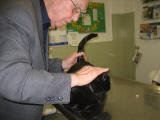 What is it?
What is it?
Leadership stroking in one way
people can teach cats to accept
gentle control by humans.
What do people do?
Massage is an art
form that most of us appreciate.
Teach your cat to appreciate this art and to accept
human hands as one of the good things
in a feline's life. Massaging your
cat is one great way to spend
quality time together that can be
relaxing for both of you.
An essential part of
leadership stroking is to
establish that you have a
higher social status in the household than does your cat. The rationale for
using leadership stroking to demonstrate status comes from the fact that cats, although not as hierarchical as
dogs, do display status posturing.
Leadership stroking is intended to establish your
elevated status, and therefore your right to
gentle touch and handle the cat. It is important that no threat is perceived by the cat. Most people report that once cats accept
and relax during leadership stroking, they enjoy it and even request it.
|
When cats learn to trust
that human hands are
friendly and not
threatening, cats become
more relaxed around their
people. |

Why do it?
In addition to
establishing your positive human
leadership in the household,
leadership stroking helps the cat
relax and accept other important
types of gentle handling. Here are a
few examples of why you may want
your cat's cooperation when being
handled.
1. Remove kitty litter from
your cats paws.
2. Trim the sharp points off of your cat's toe nails.
3. Examine
or put medicine on a sore paw
4. Check your cat's body for fleas, lumps and bumps.
5.
Give your cat grooming or treatment at home.
6. Roll your
cat over to examine skin for sores or mats.
7. Look inside your cat's mouth for
any signs of decay or discomfort.